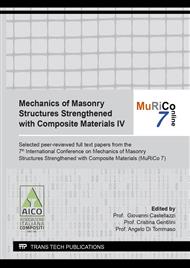[1]
C. Papanicolaou, T. Triantafillou, M. Lekka, Externally bonded grids as strengthening and seismic retrofitting materials of masonry panels, Construction and Building Materials 25 (2011) 504–514.
DOI: 10.1016/j.conbuildmat.2010.07.018
Google Scholar
[2]
F. Parisi, I. Iovinella, A. Balsamo, N. Augenti, A. Prota, In-plane behaviour of tuff masonry strengthened with inorganic matrix–grid composites, Composites Part B: Engineering 45 (2013) 1657–1666.
DOI: 10.1016/j.compositesb.2012.09.068
Google Scholar
[3]
A. Bellini, A. Incerti, M. Bovo, C. Mazzotti, Effectiveness of FRCM Reinforcement Applied to Masonry Walls Subject to Axial Force and Out-Of-Plane Loads Evaluated by Experimental and Numerical Studies, International Journal of Architectural Heritage 12(3) (2018) 376-394.
DOI: 10.1080/15583058.2017.1323246
Google Scholar
[4]
M. Del Zoppo, M. Di Ludovico, A. Prota, Analysis of FRCM and CRM parameters for the in-plane shear strengthening of different URM types, Composites Part B: Engineering 171 (2019) 20–33.
DOI: 10.1016/j.compositesb.2019.04.020
Google Scholar
[5]
F. Ferretti, C. Mazzotti C, FRCM/SRG strengthened masonry in diagonal compression: experimental results and analytical approach proposal, Construction and Building Materials (2021) 283-122766.
DOI: 10.1016/j.conbuildmat.2021.122766
Google Scholar
[6]
F. Ceroni, G. de Felice, E. Grande, M. Malena, C. Mazzotti, F.S. Murgo, E. Sacco, M.R. Valluzzi, Analytical and numerical modeling of composite-to-brick bond, Materials and Structures 47(12) (2014) 1987-2003.
DOI: 10.1617/s11527-014-0382-8
Google Scholar
[7]
A. Bellini, M. Bovo, C. Mazzotti, Experimental and numerical evaluation of fiber-matrix interface behaviour of different FRCM systems, Composites Part B: Engineering 161 (2019) 411-426.
DOI: 10.1016/j.compositesb.2018.12.115
Google Scholar
[8]
A. Bellini, S. K. Shahreza, C. Mazzotti, Cyclic bond behavior of FRCM composites applied on masonry substrate, Composites Part B: Engineering 169 (2019) 189-199.
DOI: 10.1016/j.compositesb.2019.04.009
Google Scholar
[9]
F. Ferretti, A. Incerti, A.R. Tilocca, C. Mazzotti, In-plane shear behavior of stone masonry panels strengthened through grout injection and fiber reinforced cementitious matrices, International Journal of Architectural Heritage (2019).
DOI: 10.1080/15583058.2019.1675803
Google Scholar
[10]
A. Incerti A., F. Ferretti, C. Mazzotti, FRCM strengthening systems efficiency on the shear behavior of pre-damaged masonry panels: an experimental study, Journal of Building Pathology and Rehabilitation 4:14 (2019).
DOI: 10.1007/s41024-019-0053-9
Google Scholar
[11]
F.S. Murgo, F. Ferretti, C. Mazzotti, A discrete-cracking numerical model for the in-plane behavior of FRCM strengthened masonry panels, Bulletin of Earthquake Engineering 19 (2021), 19, 4471–4502.
DOI: 10.1007/s10518-021-01129-6
Google Scholar
[12]
J. Donnini, Durability of glass FRCM systems: Effects of different environments on mechanical properties, Composites Part B: Engineering 174 (2019) 107047.
DOI: 10.1016/j.compositesb.2019.107047
Google Scholar
[13]
F. Micelli, M.A. Aiello, Residual tensile strength of dry and impregnated reinforcement fibres after exposure to alkaline environments, Composites Part B: Engineering 159 (2019) 490-501.
DOI: 10.1016/j.compositesb.2017.03.005
Google Scholar
[14]
A. Bellini, A.R. Tilocca, I. Frana, M. Savoia, C. Mazzotti, Environmental durability of FRCM strengthening systems and comparison with dry fabrics, Proceedings of 17th IB2MaC 2020 – 17th International Brick and Block Masonry Conference, Krakow, Poland, 5-8 July (2020).
DOI: 10.1201/9781003098508-50
Google Scholar
[15]
A. Dalalbashi, B. Ghiassi, D.V. Oliveira, Aging of lime-based TRM composites under natural environmental conditions, Constr. Build. Mater. 270 (2021).
DOI: 10.1016/j.conbuildmat.2020.121853
Google Scholar
[16]
L. Ombres, A. Iorfida, S. Mazzuca, S. Verre, Bond analysis of thermally conditioned FRCM-masonry joints, Measurement 125 (2018) 509-515.
DOI: 10.1016/j.measurement.2018.05.021
Google Scholar
[17]
S.R. Maroudas, C.G. Papanicolaou, Effect of High Temperatures on the TRM-to-Masonry Bond, Key Engineering Materials 747 (2017) 533-541.
DOI: 10.4028/www.scientific.net/kem.747.533
Google Scholar
[18]
A. Iorfida, S. Candamano, F. Crea, L. Ombres, S. Verre, P. De Fazio, Bond Behaviour of FRCM Composites: Effects of High Temperature, Key Engineering Materials 817 (2019) 161-166.
DOI: 10.4028/www.scientific.net/kem.817.161
Google Scholar
[19]
Consiglio Superiore dei Lavori Pubblici, Linea Guida per la identificazione, la qualificazione ed il controllo di accettazione di compositi fibrorinforzati a matrice inorganica (FRCM) da utilizzarsi per il consolidamento strutturale di costruzioni esistenti (in italian), (2018).
DOI: 10.3221/igf-esis.12.04
Google Scholar
[20]
EN 1015-11:1999/A1:2006. Methods of test for mortar for masonry - Part 11:Determination of flexural and compressive strength of hardened mortar (2006).
DOI: 10.3403/01905442u
Google Scholar


